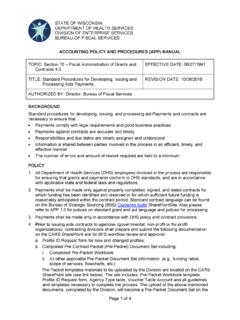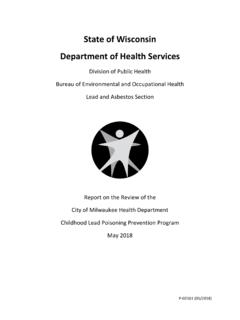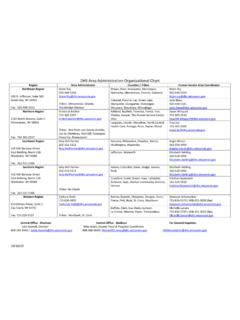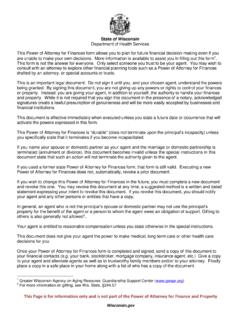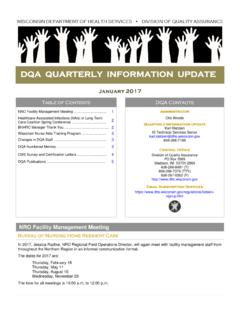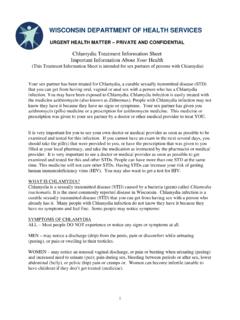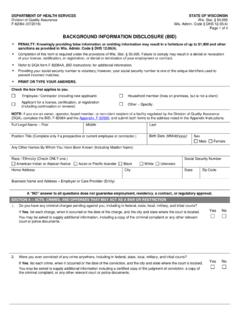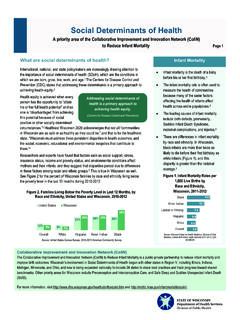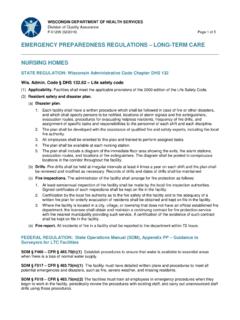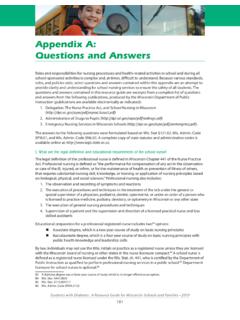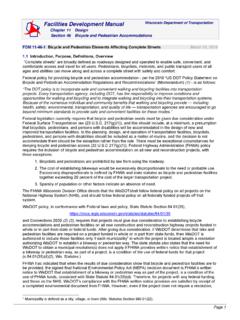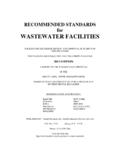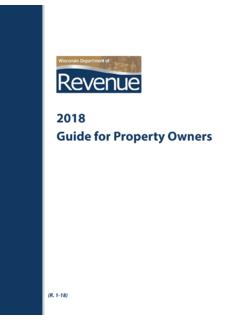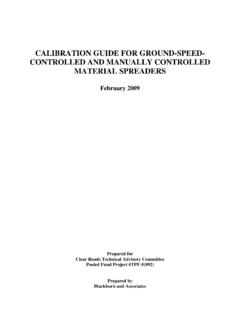Transcription of CHAPTER I - OVERVIEW AND ADMINISTRATION …
1 Medicaid Waivers manual CHAPTER I OVERVIEW and ADMINISTRATION Page I-1 January 2010 CHAPTER I - OVERVIEW AND ADMINISTRATION Long Term Support in wisconsin The Medicaid Home and Community Based Waiver (HCBW) programs were authorized by Congress in 1981, and began in wisconsin in 1983 with the Community Integration Program. The Medicaid waivers represented a significant step, taken to mitigate the Medicaid program s institutional bias that had led to the extensive development and utilization of nursing homes and Intermediate Care Facilities for the Mentally Retarded (ICF-MR), also called Facilities for the Developmentally Disabled (FDD).
2 Recognizing the problem, wisconsin had taken its own steps to reverse the trend toward institutionalization with the creation of the Community Options Program (COP). Created in 1981, COP was developed to provide eligible persons a safe community alternative to institutional placement. In addition, COP was designed to bring a system of care management and service coordination to the complex world of community services while placing the consumer in the center of the service planning process. The program intent is to forge a working partnership between the participant and the care manager/ support and service coordinator (CM/SSC), in which they jointly develop a plan that addresses the participant s identified needs and meets her/his desired individual outcomes.
3 While keeping the participant s preferences in mind, the care manager or support and service coordinator, participant and other team members seek the most cost-effective means to meet those individual outcomes in an integrated community setting. The Medicaid waiver programs are built upon a foundation of primary program values. These values support individual choice, the enhancement of relationships, the building of accessible, flexible service systems, the achievement of optimum physical and mental health for the participant, and the promotion of presence, participation and optimal social functioning in the community. The program values further seek to ensure that participants are treated with respect and assure that service systems empower the individual, build on their strengths, enhance individual self worth and supply the tools necessary to achieve maximum independence and community participation.
4 The Medicaid waiver programs covered in this manual include: Brain Injury Waiver (BIW) Children s Long Term Support Waivers (CLTS) Community Integration Program 1A Waiver (CIP 1A) Community Integration Program 1B Waiver (CIP 1B) Community Integration Program II Waiver (CIP II) Community Options Program Waiver (COP-W) Community Opportunities and Recovery (COR) Medicaid Waivers manual CHAPTER I OVERVIEW and ADMINISTRATION Page I-2 January 2010 There are several other community waiver programs that serve similar populations that are not addressed by this manual . These include the managed care programs, Family Care, PACE, Partnership and the self directed supports Medicaid waiver program, IRIS (Include, Respect, I Self-Direct.)
5 Policies described in this manual are grounded in CHAPTER 46 wisconsin Statutes and DHS administrative rules and in provisions contained in the several Medicaid waiver applications submitted to and approved by the federal Centers for Medicare and Medicaid Services (CMS). State Medicaid Agency Authority This revision of the Medicaid Waivers manual implements revised policies that address the State County relationship in the operation of the Medicaid waivers. Previously, the state delegated certain authority to county agencies to make local decisions, set priorities and develop county program policy. The Department, working with the federal Centers for Medicare and Medicaid Services in the waiver renewal process, has agreed to rescind that policy and assume sole authority in all Medicaid Waiver policy and program operations.
6 Sole authority with the State Medicaid Agency (DHS) means that county agencies may not set local policy, determine waiver program priorities or enact and enforce local terms in the agency- service provider relationship. manual holders will note new requirements for: Medicaid Waiver wait list operations ( CHAPTER I); for waiver program provider agreements ( CHAPTER IV) and for assessment content (Medication Monitoring) in CHAPTER VI. These changes, and others, bring our waiver policy and program practice into compliance with the federal mandate for sole State Medicaid Agency authority. The requirements are outlined in the manual and in DLTC Numbered Memos, cited where applicable.
7 The Medicaid Waiver Mandate By statute (s. (6r) (a), regular COP (State only) funds may not be used for long-term support services that may be funded under one of the Medicaid Home and Community Based Waiver programs. The waiver mandate is intended to increase the total resources available to serve participants while maximizing the use of federal funds to support the provision of community-based services. Waiver funds must be used when: The participant is eligible or becomes eligible for the waiver; and The agency has Medicaid waiver resources available; and The services to be provided are covered by the waiver.)
8 Medicaid Waivers manual CHAPTER I OVERVIEW and ADMINISTRATION Page I-3 January 2010 A. Eligibility The waiver agency must seek Medicaid waiver funding unless the applicant is found to be ineligible for the Medicaid community waivers. The mandate does not apply when: 1. The person does not meet Medicaid waiver level of care eligibility requirements; or 2. The person does not meet Medicaid financial eligibility requirements; or 3. The person does not meet Medicaid waiver program nonfinancial eligibility requirements, including residency status, etc.; or 4. The person does not meet the Medicaid waiver target group criteria; or 5.
9 The person s preferred living arrangement is appropriate to meet his/her needs but is not an allowable living arrangement under the applicable Medicaid waiver (see CHAPTER II of this manual ). B. Availability Medicaid waiver resources are considered available if: 1. The agency has unused CIP 1A, CIP 1B (state-matched) or CIP II slot that can be designated for a locally matched slot in CIP 1B or BIW or CLTS; or 2. The agency has unused COP-Waiver match allocated by the state that is not fully committed to current participants. 3. The agency has unused state funds (COP, Community Aids or other funds) allocated by the state that are not expended.
10 While not a specific obligation of the waiver agency, a child participating in the Family Support Program (FSP) who is also eligible for the waiver should have those FSP funds used to match federal funds under the appropriate waiver. Exemptions from the Waiver Mandate While the mandate does not apply where Medicaid waiver eligibility cannot be established, there are also exemptions to the waiver mandate. Persons exempt from the waiver mandate include: 1. Any person for whom a Medicaid waiver application is being processed is exempt for up to 90 days, provided that within the first ten days after services are initiated: Medicaid Waivers manual CHAPTER I OVERVIEW and ADMINISTRATION Page I-4 January 2010 a.
